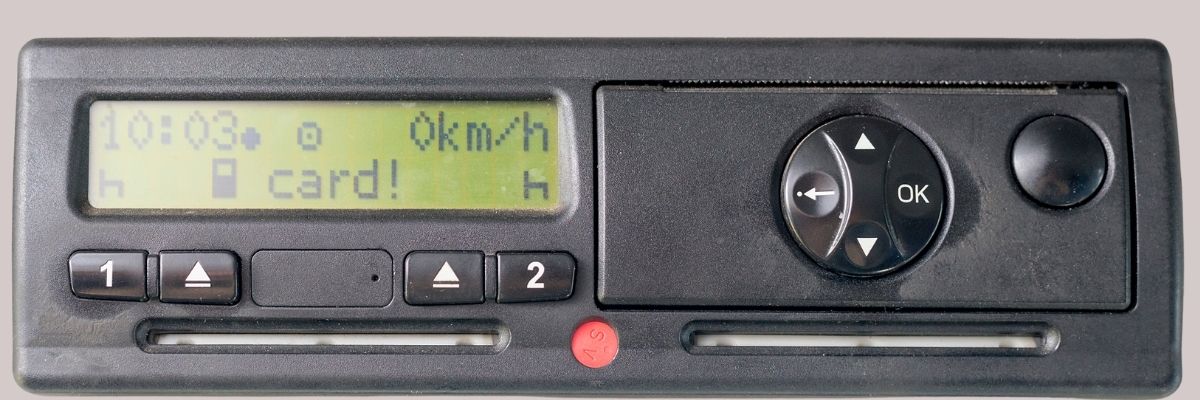Tachographs are installed in all commercial vehicles in the UK if the total weight of the vehicle exceeds 3.5 tonnes, having knowledge of the UK truck drivers tachograph can really help with understanding some of the rules especially if you are a new driver to the industry.
What is a Truck Drivers Tachograph?
A tachograph keeps a record of what a driver is doing on a tachograph chart or digital card so that the
authorities can check that the driver is within the drivers’ hours rules.
The tachograph is situated in the cab of the lorry.
Driver’s information and the information relating to the vehicle are stored within the unit or on the driver’s card, this information can be retrieved from both the tachograph unit and the driver’s card for analysis.
UK Truck Drivers Tachograph Requirements
Truck Drivers using a digital tachograph must:
- check that the tachograph doesn’t need a recalibration
- ensure there are sufficient supplies of print roll within the vehicle so that any enforcement officer can take a printout if necessary
- data entry manual records in UTC and confirm the start location as instructed by the equipment
- ensure the mode switch is set correctly throughout their shift
- tell the operator if the tachograph is faulty or if they’re unsure how to use it properly
- make a printout and provide written manual entries if it’s impossible for them to use their card, the rules have been broken due to an emergency, or an enforcement officer requests it (they may also be asked to sign that it’s a true record)
- be able to produce the relevant records at the roadside
- allow the operator to download data from their card
Truck Drivers using an analog tachograph must:
- check the time is set to the official time of the country in which the vehicle is registered
- make sure the tachograph doesn’t need an inspection or recalibration by checking the seal is intact and the plaque is in date
- complete all center field details on every chart. However, the ‘total km’ field is not legally required to be completed
use a chart that’s compatible with the tachograph - tell the operator if the tachograph is faulty or if they are unsure how to use it properly
- ensure the mode switch is set correctly throughout each shift
- make written manual entries when working away from the vehicle and unable to use the recording equipment, or if the rules have been broken because of an emergency
- record the registration number and odometer reading of any new vehicle used on the shift, together with the time of the vehicle changeover
- be able to produce the relevant records at the roadside
- return charts, which they are not required to keep, to the O license holder as soon as possible, but in any case within 42 days
Note: A driver who is not in possession of a driver card cannot drive a vehicle equipped with a digital tachograph.
What If My Driver Card Stops Working?
If your driver card suddenly won’t work in the tachograph you must, at the beginning and end of each shift, do a printout from the tachograph unit. You must make a manual entry showing the details of each activity on the back of a printout, provide as much information as possible relating to your shift also sign and date it.
What If The Tachograph Unit Stops Working?
If a tachograph unit stops working during your journey, it is important that you keep a manual record of your driving hours and breaks, write down as much information as possible including start time, break times, and finish time.
If you are travelling long distances involving being away from your base for a period of more than a week then the tachograph must be repaired during your journey, liaise with your transport manager who will find a tachograph repair centre local to you.
UK Tachograph Rules For Driving a Truck?
How long can I drive my truck?
- Daily limit: 9 hours (Can be increased to 10 hours twice a week)
- Weekly limit: 56 hours between 00:00 Sunday and 23:59 the following Saturday
- In any two consecutive weeks: 90 hours in total
How much ‘rest’ time should I take?
- Daily rest: 11 consecutive hours in any 24 hour period (Can be reduced to 9 hrs no more than 3 times between weekly rest periods).
- Weekly rest: 45 consecutive hours – within six 24 hour periods from the end of the last weekly rest period a daily rest period must be extended into a period of 45hrs. In any two consecutive weeks, one weekly rest can be reduced to at least 24 hours but any reduction must be made up by the end of the 3rd week following
Why have the rules?
Drivers’ hours are restricted for safety reasons. In short, if the driver works too many hours he may fall asleep at the wheel.
Breaking the tachograph law can lead to the driver being heavily fined and/or losing their license.
Thank you for reading this Article “UK Truck Drivers Tachograph” if you would like to leave a comment on your views please do so below.




